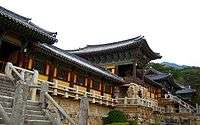Byeonhan confederacy
Byeonhan (Hangul: 변한; Hanja: 弁韓; RR: Byeonhan, Korean pronunciation: [pjʌn.ɦan]), also known as Byeonjin,[1] (Hangul: 변진; Hanja: 弁辰; RR: Byeonjin, Korean pronunciation: [pjʌn.dʑin]) was a loose confederacy of chiefdoms that existed from around the beginning of the Common Era to the 4th century in the southern Korean peninsula. Byeonhan was one of the Samhan (or "Three Hans"), along with Mahan and Jinhan.[2]
History
This early part of the Three Kingdoms period is sometimes called the Proto–Three Kingdoms period. Byeonhan, like the other Samhan confederacies, appears descended from the Jin state of southern Korea.
Archaeological evidence indicates an increase in military activity and weapons production among the Byeonhan in the 3rd century, especially an increase in iron arrowheads and cuirasses (Barnes 2000).[2] This may be associated with the decline of Byeonhan and the rise of the more centralized Gaya Confederacy, which most Byeonhan states joined. Gaya was subsequently annexed by Silla, one of the Three Kingdoms of Korea.
Culture and trade
The Chinese Records of Three Kingdoms state that the language and culture of Byeonhan was essentially the same as Jinhan, and archaeological artifacts show little difference. Byeonhan may have simply referred to the chiefdoms in the south and west of the Nakdong River valley[3] which were not formal members of the Jinhan confederacy.
According to the 3rd-century Chinese chronicle Records of Three Kingdoms, Byeonhan was known for the production of iron;[4] it exported iron to the Han commanderies to the north, Yamato Japan[4][5] and the rest of the Korean peninsula.[6] It was also a center of stoneware manufacture.
Member statelets
According to the Records of Three Kingdoms, Byeonhan consisted of 12 statelets:
- Mirimidong (미리미동국/彌離彌凍國), present-day Miryang.
- Jeopdo (접도국/接塗國), present-day Haman.
- Gojamidong (고자미동국/古資彌凍國), present-day Goseong.
- Gosunsi (고순시국/古淳是國), present-day Jinju, Sacheon or Goseong.
- Ballo (반로국/半路國), present-day Seongju.
- Nangno (낙노국/樂奴國), present-day Hadong or Namhae.
- Gunmi (군미국/軍彌國), present-day Sacheon.
- Mioyama (미오야마국/彌烏邪馬國), present-day Goryeong.
- Gamno (감로국/甘路國), present-day Gimcheon.
- Guya (구야국/狗邪國), present-day Gimhae.
- Jujoma (주조마국/走漕馬國), present-day Gimcheon.
- Anya (안야국/安邪國), present-day Haman.
- Dongno (독로국/瀆盧國), present-day Dongnae.
See also
References
- Barnes, G.L. (2000). Archeological armor in Korea and Japan: Styles, technology and social setting. Journal of East Asian Archeology 2 (3–4), 61–96. (Electronic Version).
- ↑ Huiyi, Yi; Songsu, Park; Naehyon, Yun (2005). New history of Korea. Seoul: Jimundang. p. 136. ISBN 8988095855.
- 1 2 Ebrey, Patricia; Walthall, Anne (2013-01-01). Pre-Modern East Asia: A Cultural, Social, and Political History, Volume I: To 1800. Cengage Learning. p. 101. ISBN 1133606512.
- ↑ Yi, Kwang-kyu (2003). Korean studies series (Korean Studies series 25 ed.). Seoul: Jipmundang. pp. 24–27. ISBN 8988095499.
- 1 2 Lee, Injae; Miller, Owen; Park, Inhoon (2014). Korean History in Maps. Cambridge University Press. pp. 18–19. ISBN 1107098467.
- ↑ Kyong-hee, Won Yu han ; translated by Lee (2006). Money traditional Korean society. Seoul, Korea: Ewha Womans University Press. pp. 17–18. ISBN 8973006746.
- ↑ Mong-nyong, Choi (2006). 최근 의 고고학 자료 로 본 한국 고고학, 고대사 의 신 연구(Recent research on archaeology and ancient deities. Seoul: Juryusung. p. 41. ISBN 9788987096650.
